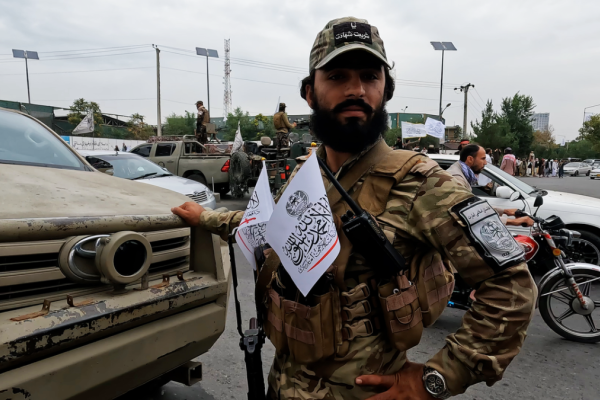Forced disappearances in Kandahar show need for Canadian Afghanistan Papers
New research shows the Canadian military was involved in the ‘enforced disappearances’ of hundreds of Afghan detainees

Canadian troops arrive at Kandahar airfield on March 8, 2002. Photo by Stephen J. Thorne.
Last month, the Globe and Mail published an article about “enforced disappearances” of Afghan prisoners by Canadian troops in Kandahar. So far, no other Canadian news outlet has reported on the serious allegations in the piece, which offer a rare peek through Ottawa’s wall of censorship at the actual functioning of Canadian military operations abroad.
The source of the allegations is Richard Colvin, a Department of Foreign Affairs (now called Global Affairs Canada) veteran who rose to prominence in 2009 as one of the main whistleblowers regarding Canadian complicity in the torture of Afghan civilians. For testifying to Parliament about the torture scandal, Colvin faced government retaliation. He was “denied promotions that normally would be routinely granted to a diplomat of his rank, and federal lawyers threatened him with prosecution for his decision to testify.”
Since then, Colvin has been compiling additional information about the Canadian military’s treatment of Afghan prisoners. His findings are disturbing. If true, they constitute what Colvin calls “a grave war crime” on a “massive scale.”
Colvin’s report draws from “hundreds of public and private sources,” and details how, during Canada’s occupation of Kandahar Province, Canadian soldiers conspired to secretly detain and transfer hundreds of Afghan prisoners to the central government’s security apparatus. Many of these Afghans were local farmers with no connection to militant anti-occupation forces.
These actions by the Canadian military and diplomatic service constituted an “unauthorized and undeclared” policy on a “massive scale,” and a deliberate evasion of a 2005 treaty signed between Canada and Afghanistan in which Ottawa promised to alert the International Committee of the Red Cross (ICRC) whenever Canadian soldiers handed over detainees to Afghan government forces.
“At the peak of the Kandahar mission in 2006 and 2007, as many as 90 percent of the Afghans detained by Canadian soldiers simply disappeared from any official monitoring.”https://t.co/hWy4Pqk6VE
— So-Called "Communist Hamburgler" (@JeremyAppel1025) December 31, 2024
Rather than notify the ICRC, the Canadian military labelled prisoners as PUCs (Persons Under Control), a term borrowed from the US military, which allowed them to keep the Red Cross in the dark and thereby bypass international monitoring of prisoners. As a result, hundreds of Afghans arrested by Canadian forces “disappeared into the custody of Afghan security forces that had a well-known history of torture, abuse and even murder.”
Colvin asserts that from 2006-2007, the most intense period of Canada’s occupation of Kandahar, “as many as 90 percent of the Afghans detained by Canadian soldiers simply disappeared from any official monitoring,” subject instead to what Colvin calls “enforced disappearances.” During the first year of the Canadian-led Provincial Reconstruction Team (PRT), “Canada secretly detained and transferred about 1,000 people to the Afghan security forces, and possibly as many as 1,200.” Only 129 Afghan prisoners were officially transferred to the Afghan government.
“The willful transfer of prisoners to a significant risk of abuse, torture or murder is prima facie a grave war crime,” Colvin stated. “So, too, is their enforced disappearance.”
“A mindset of cynicism, non-accountability, and legal impunity”
While Canada allegedly delivered hundreds of unacknowledged Afghan prisoners to unknown fates, it must be noted that the Afghan detainees whose existence Canada reported fared little better.
As the torture revelations of 2007-2009 showed, Canada routinely delivered acknowledged prisoners to Afghan government jails where they were “whipped, beaten, starved, choked and subjected to electric shocks, despite Canadian assurances that their rights were being protected.” Then Prime Minister Stephen Harper prorogued Parliament in order to shut down the investigation into these reports. Justin Trudeau, despite initially supporting calls for an inquiry into Canadian complicity in the torture of Afghans, backtracked after becoming prime minister in 2015.
It appears that Afghan prisoners were not only tortured in the custody of the Western-backed central government. Canadian forces seemingly tortured prisoners too, as reported by law professor Amir Attaran in 2007. Through Access to Information, Attaran acquired three handwritten reports from Canadian military police in Kandahar. Attaran reported that the documents “show three men were brought to military police by a single interrogator in one day with injuries to their faces, heads and upper bodies… the men had swollen eyes, cuts on their eyebrows, gashes to their forehead and slashes on their cheeks.”
What’s more, insiders have alleged that Canadian forces repeatedly and knowingly killed Afghan civilians, that those who spoke out faced retaliatory action, and other soldiers were threatened against following their example.
In 2008, Claude Lepage, a member of Canadian special forces unit Joint Task Force 2 (JTF2), reported to the military ombudsperson’s office that he felt his team was “being encouraged [by suoeriors] to commit war crimes by the chain of command.” In one example, “a member of the unit fired an anti-tank weapon at a civilian residence and then conducted a ‘dynamic entrance’ to surprise and intimidate the people inside.”
In another case, “members of the unit bombarded several civilian residences… Lepage visited the destroyed homes afterward and met an old man carrying a bag filled with human remains. The man said the remains were what was left of his family.”
Yet another: “…an unarmed man appeared at a JTF2 detachment in Afghanistan with his hands in the air, apparently surrendering amid an operation the Canadian military had dubbed ‘Bad Doctor.’ Members of the unit yelled at him not to move, but the detachment’s commander then shot the man five times, killing him on the spot.” The murderer of this unarmed man was allegedly promoted to sergeant.
Similar to Colvin, Lepage says he faced “retaliatory measures” after reporting these war crimes to the Canadian government. He was demoted, his salary halved, then he was kicked out of JTF2. Other soldiers reported that Michael Rouleau, head of the unit, threatened JTF2 members against speaking out. According to Sergeant Paul Demers:
Rouleau made, in my presence and in front of members of the unit, disapproving comments about Mr. Lepage’s behaviour and the fact that he denounced the death of an Afghan civilian… Mr. Rouleau implied that the unit disapproved of the fact that [Lepage] denounced the situation and that the treatment Lepage received would apply to those who denounced similar situations.
In fact, Canadian forces regularly killed Afghan civilians, but in general, these incidents did not get back to the Canadian public due to an enormous state and private media propaganda campaign designed to imbue Canadians with patriotic fervor for the Afghanistan mission.
As I wrote in my book Canada in Afghanistan: A story of military, diplomatic, political and media failure, 2003-2023, military and government officials made up almost half (47 percent) of all primary sources in Canadian newspapers, and they were the most-cited secondary sources. Canada’s media was 11 times more likely to quote a Canadian official than an Afghan official or civilian, and 158 times more likely to quote a Canadian official than an anti-war advocate. Ottawa’s carefully crafted narrative about the occupation thus dominated its public perception in Canada.
According to Colvin’s latest report on enforced disappearances, Canadian military and diplomatic conduct in Afghanistan encouraged “a mindset of cynicism, non-accountability and legal impunity.” The above examples reinforce this claim.
A Canadian soldier escorts an Afghan detainee. Photo courtesy Department of National Defence.
Law and human rights for “public consumption,” not practice
According to Colvin, the Canadian government learned during the Afghanistan occupation that human rights and the rule of law were for “public consumption,” not practice.
One can take issue with Colvin’s assertion that Ottawa “learned” the emptiness of Western human rights rhetoric in Afghanistan (in my book I show that Canadian officials were quashing reports of war crimes by Canadian forces since at least the Korean War of 1950-1953) but not with his fundamental argument. There was a massive disconnect between the rosy image of Canadian benevolence crafted by media and the state, and the occupation’s on-the-ground reality.
Canadian leaders spoke about building democracy in Afghanistan, furthering women’s rights, and creating just and sustainable government institutions, while Canadian advisors helped build a military, judicial, and economic system in the country that many Afghans viewed as corrupt, unaccountable, and repressive. Many Western participants in the occupation knew this very well. As one former security advisor told the Toronto Star: “If I were Afghan, I too would join the insurgency in a heartbeat. Compared to the [Western-backed] Karzai group, the Taliban comes across as Robin Hood.”
Protecting the brand
Shortly before retiring from public service in May 2024, Colvin submitted an overview of the disappearances document to Global Affairs and requested a meeting with Deputy Minister David Morrison. “In his submission,” the Globe reports, “Mr. Colvin identified nine lessons that Canada should take from the Afghan detainee affair to prevent its recurrence, including steps to improve the transparency of Canada’s military missions, greater civilian oversight of the military, reforms to the military justice system and a new law to require the vetting of the legality of Canada’s policies and practices abroad.”
Morrison did not grant Colvin a meeting. Colvin also submitted the document to the Department of National Defence, but a spokesperson simply stated, “We have received the document and are reviewing the contents.”
Indeed, during the war, embedded reporter Murray Brewster asserted, “I can’t emphasize how political this thing was. It’s all about protecting the brand.”
Military historian Sean Maloney, who was commissioned by DND to write a history of the mission, reported that Canadian officials tried to “step in and interfere” with the book’s writing. When it became clear that Maloney intended to criticize Canadian government conduct, a colonel warned Maloney that he “can’t contradict an established Canadian position, for political reasons.” Portions of the book were rewritten without Maloney’s consent. Publication was delayed for nearly a decade, and when the three-volume history was finally released, distribution was limited to 800 copies each in English and French.
Where are Canada’s Afghanistan Papers?
In December 2019, the Washington Post won access to hundreds of internal interviews with US government and military officials speaking about the war in Afghanistan. The documents, nicknamed the Afghanistan Papers, proved that the US government knew they had lost the war but continued to lie to the public in order to justify continued occupation.
Where are Canada’s Afghanistan Papers? They exist, in fact, but Canadians aren’t allowed to see them.
During the Harper government years, around 500 internal interviews were conducted on the topic of Canada in Afghanistan. So far, the only document produced by this secret review that Canadians can read is a 10-page summary consisting purely of “cheerleading” and “back-patting.”
More than a decade after Canada’s withdrawal from Afghanistan, the interviews are still hidden behind a wall of state censorship.
In a sense, Colvin’s revelations about forced disappearances in Kandahar reaffirms what we already knew: Canadian actions on the ground completely contradicted the lofty statements about democracy and human rights espoused by politicians and military command.
The revelations also show that Canadians deserve an Afghanistan Papers of their own. We deserve to know how the occupation functioned internally, what Canadian officials truly thought of events on the ground, and how much they knew about the torture and disappearance of Afghan prisoners. Getting this information, however, has proven more difficult that wringing truths out of Washington.
Owen Schalk is a writer from rural Manitoba. He is the author of Canada in Afghanistan: A story of military, diplomatic, political and media failure, 2003-2023 and the co-author of Canada’s Long Fight Against Democracy with Yves Engler.










